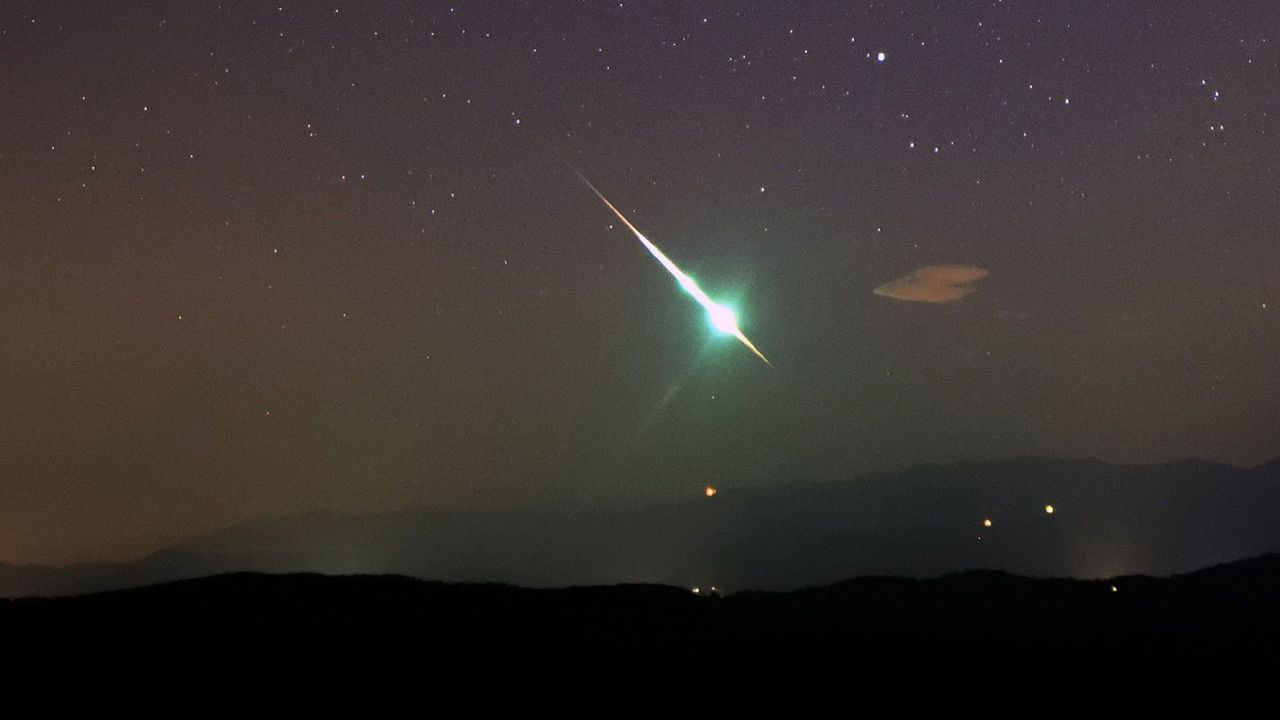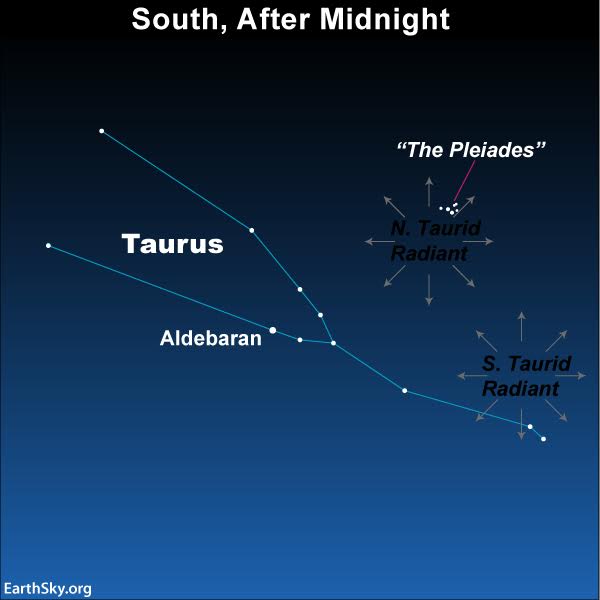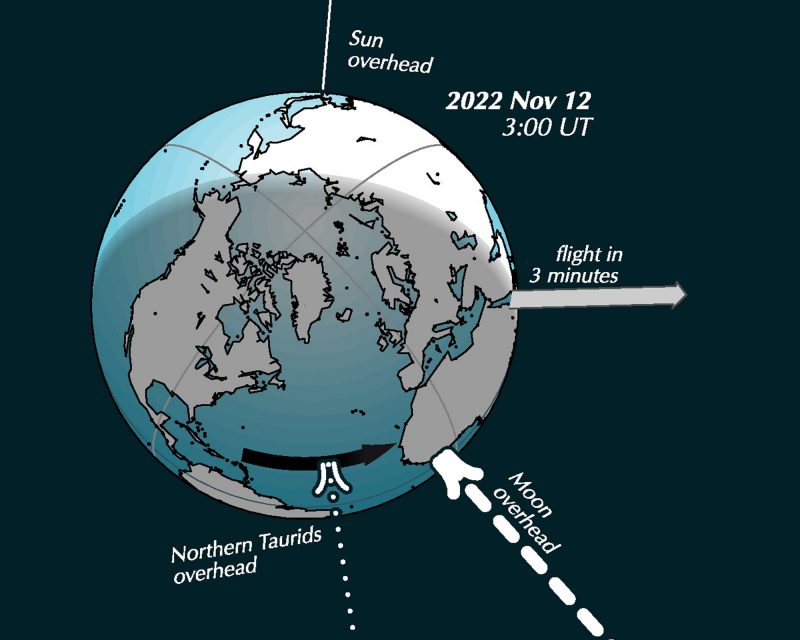[ Skywatchers ] [ Main Menu ]
46954

From: Eve, [DNS_Address]
Subject: November Southern Taurids meteor shower will feature bright fireballs
URL: https://www.cnn.com/2022/11/04/world/south-taurids-meteor-shower-fireballs-scn/index.html
|
image caption:A bright fireball is seen above Brkini, Slovenia, on November 12, 2015, during a Taurid swarm. This month, another swarm is upon us, with fireballs that can be seen in the sky throughout November. This month’s Southern Taurids meteor shower will feature bright fireballs in the sky By Taylor Nicioli, CNN Published 6:24 AM EDT, Fri November 4, 2022 Never mind that Halloween is over, because “Halloween fireballs,” as NASA calls them, can still be seen blazing bright in the night sky over the next few weeks, thanks to the Southern Taurids meteor shower. The shower’s estimated peak isn’t until Saturday, November 5, according to EarthSky, and the Taurids are famous for producing the most and brightest fireballs — meteors that can appear brighter than the planet Venus. This year’s shower is expected to include an increased number of fireballs, otherwise known as a Taurid Swarm. The Southern Taurids usually only feature around five meteors an hour surrounding its peak, the point where Earth is closest to the center of the stream of debris. But every seven years, Jupiter’s gravity pulls on the meteor stream and causes a spike in their numbers. “With the normal rate for fireballs, someone would have to sit outside for 20 hours straight to see one,” said Robert Lunsford, fireball report coordinator for the American Meteor Society. “With the Taurids, (that time) can be reduced quite a bit, maybe down to five hours. And if you’re really lucky, you could just step outside and within a few minutes see one. When they appear is totally unpredictable.” Origin of the Taurids The Taurids are the result of a breakup of a very large comet around 20,000 years ago. Among other debris, that breakup created Comet Encke, which has an orbit around the sun of a little more than three years, the shortest of any major comet in our solar system. With every pass of Earth in its short orbit, it leaves a trail of debris behind. This trail includes the Southern Taurids, which are a cluster so large it takes our planet several weeks to pass through. “Most meteor showers contain tiny bits of dust. Well, the Taurids … also has some large particles,” said Bill Cooke, NASA Meteoroid Environment Office lead. “And you’ll see, while the shower is active, not dust particles, but pebble-sized particles — and some (that) are football-sized and larger, which of course, produce brilliant, brilliant fireballs.” Seeing a fireball Fireballs from the Taurids are meteors larger than a meter across, and they shine exceptionally bright, according to NASA. They move slow because they strike the Earth’s atmosphere at a perpendicular angle, so they can be seen moving across the sky for a few seconds, versus the millisecond of visibility most meteors yield. The brighter and longer-lasting meteors can be seen fragmenting and falling apart as they travel through the sky, according to Lunsford. Oftentimes, the fireballs are colorful, appearing red, orange or yellow. “It would be like a shooting star,” said Mike Hankey, the American Meteor Society’s operations manager and creator of its fireball tracking program. “But instead of lasting a half of a second, it might last for three or four seconds, and instead of just being as bright as a star, it might be as bright as the moon — sometimes even brighter.” This year the meteor society has already recorded an above-average increase in fireballs, while NASA has photographed fireballs that appear to be even brighter than the moon in the night sky. The best time to go out and spot a fireball will be at 2 a.m. local time throughout the next week, according to Lunsford. As the moon approaches its full moon stage set for November 8, its brightness will start to disrupt the chances of fainter meteors being seen, but fireballs, due to their size and brightness, can be seen anywhere in the world, at any time during the night. Other space events this year There are four more meteor showers you can see in the remainder of 2022, according to EarthSky’s 2022 meteor shower guide: starlead A beginner's guide to stargazing (Courtesy CNN Underscored) • November 12: North Taurids • November 18: Leonids • December 14: Geminids • December 22: Ursids And there are two more full moons on The Old Farmer’s Almanac 2022 calendar: • November 8: Beaver moon (which will peak alongside a total lunar eclipse) • December 7: Cold moon |
Responses:
[46955]
46955

From: Eve, [DNS_Address]
Subject: Re: November Southern Taurids meteor shower all you need to know
URL: https://earthsky.org/astronomy-essentials/taurid-meteors-all-you-need-to-know/
|
https://earthsky.org/astronomy-essentials/taurid-meteors-all-you-need-to-know/ image caption: Taurid meteors consist of 2 streams, the South Taurids and North Taurids. Both streams radiate from the constellation Taurus the Bull, not far from the bright star Aldebaran and the tiny, misty, dipper-shaped Pleiades. Taurus is high in the sky in the middle of the night now. So the hours around midnight are a good time to watch for Taurid meteors and fireballs. appear to originate from the constellation . In October and November, this constellation is highest in the sky in the middle of the night. 2022 might bring an enhanced number of Taurid fireballs. Especially during the 2-week period centered on November 5, you might see several fireballs each night instead of the normal rate of one every 20 hours. Predicted peak: The South Taurids’ predicted* peak is November 5, 2022, at 18 UTC. The North Taurids’ predicted* peak is November 12, 2022, at 18 UTC. Neither shower has a very definite peak. Both ramble along in October and November and are especially noticeable from late October into early November, when they overlap. When to watch: Best around midnight, and probably best from late October into early November. Watch for enhanced rates of fireballs (very bright meteors) for the 2-week period centered on November 5. Overall duration of shower: The South Taurids run from about September 23 to November 12. North Taurids are active from about October 13 to December 2. Radiant: Rises in early evening, highest in the sky around midnight. See chart below. Nearest moon phase: In 2022, new moon falls on October 25. Full moon is November 8. So late October – when the two showers overlap and there’s no moon – might be excellent for the Taurids in 2022. This custom sunrise-set calendar can show you moon rising times for your location. Be sure to check the moon rising time box. Expected meteors at peak, under ideal conditions: Under dark skies with no moon, both the South and North Taurid meteor showers produce about five meteors per hour (10 total when they overlap). In 2022, watch for fireballs. Note: Taurid meteors tend to be slow-moving but sometimes very bright. The American Meteor Society has pointed to “a seven-year periodicity” with Taurid fireballs. 2008 and 2015 both produced fireballs, or particularly bright meteors. 2022 might as well. The last Taurid fireball display, in 2015, was really fun! Watch for Taurid fireballs in 2022! The Northern Taurids parent comet This section is by the late, great Don Machholz (1952-2022), who discovered 12 comets … The object responsible for the Northern Taurid meteor shower is believed to be an asteroid. And that asteroid is related to a comet. The asteroid is named 2004 TG10. The Spacewatch program discovered it on October 8, 2004. Its orbit around the sun closely matches that of periodic Comet Encke (officially known as 2P/Encke). Scientists believe this asteroid was once part of a much larger object known as the Encke Complex. The most widely accepted theory is that about 20,000 years ago, a much larger object broke up, creating Comet Encke and several asteroids and meteor showers. Scientists named this group of resultant objects after the most prominent member of the group: Comet Encke. Hence, the Encke Complex. A recent study indicates that the asteroid 2004 TG10 is only one of 10 related asteroids that may be responsible for this meteor shower. If that is true, then no single asteroid is producing the material causing the Northern Taurid meteors. How is a mystery like this solved? Time and teamwork. Special night-time video cameras record incoming meteors, and computers calculate the orbit almost immediately. Scientists compare these orbits to known objects, such as comets and asteroids. A direct match is unlikely, because any piece of material ejected from a comet or asteroid – perhaps hundreds of years ago – has been subjected to solar radiation and planetary perturbations, changing its path around the sun. So, its final orbit, just before it enters our atmosphere, is likely different than the orbit it originated from. Astronomers who specialize in celestial mechanics will be the ones to bring us the solution. Cameras and computers are likely to give us a better picture and a more thorough understanding of the Northern Taurids meteor shower. The Southern Taurids parent comet From Don Machholz … The material we see as meteors from the Southern Taurids radiant comes from the comet known as Encke’s Comet. Officially known as 2P/Encke, this comet was discovered four times before it received its name. The French comet hunter Pierre Mechian discovered it on January 17, 1786. He observed the comet for only three days and did not calculate its orbit. Next up was Caroline Herschel of England, who found it on November 7, 1795, 10 years later. She tracked it for 23 days but did not calculate an accurate orbit. Ten years later, Frenchman Jean-Louis Pons, the greatest visual comet hunter of all time, picked it up on October 20, 1805. Within hours of Pons’ discovery, Hofrath Huth of Germany and Bovard in Paris picked it up too. This time they followed it for 32 days. Enter Johann Franz Encke. Using these positions, he calculated an orbit for this comet and predicted that it would return. End of story? No, because he predicted it would return in 12.12 years. And it didn’t. Then, on November 26, 1818, Pons picked up a comet and tracked it for 48 days. Encke calculated an orbit for this one, and using some new computing techniques, came up with an orbital solution suggesting the comet takes only 3.3 years to go around the sun once. After six weeks of work, he was also able to link this comet to the comets of 1786, 1795 and 1805. He then correctly predicted that it would return in 1822. Based upon his work correctly calculating the comet’s orbit, the comet received the name Encke. Comet Encke has the shortest orbital period of any major comet in our solar system. At its closest, it gets as close to the sun as does the planet Mercury, the planet closest to the sun. The orbit is stable, and the comet has probably been in the same orbit for thousands of years. A recent theory is that Comet Encke was once part of a larger comet that broke up about 20,000 years ago. This event produced several small asteroids and debris that now forms this meteor shower. And there are more. Scientists attribute at least three other meteor showers to Comet Encke. One stream of material might have delivered the object responsible for the Tunguska meteor event of 1908. This whole system is known as the Encke Complex. The next return of Comet Encke will be in October 2023. Observers in the Northern Hemisphere will have a good view of the comet in the morning sky, where it might get as bright as magnitude seven, meaning you will need binoculars to see it. The fireballs left behind by the comet are much brighter and much more interesting. Taurid fireballs in 2022? The American Meteor Society said in 2022: When the two showers are active simultaneously in late October and early November, there is sometimes a notable increase in the fireball activity. There seems to be a seven-year periodicity with these fireballs. 2008 and 2015 both produced remarkable fireball activity. 2022 may be the next opportunity.  The South Taurids – the better known of the 2 displays of Taurid meteors – run from about September 10 to November 20. That’s when Earth passes through the stream of cometary debris that Comet 2P/Encke left behind. Watch around midnight, when the radiant is highest in the sky. Image via Guy Ottewell. Used with permission.  The North Taurids are active from about October 20 to December 10. Like the South Taurids, they also come from Comet 2P/Encke. Apparently, the gravity of the giant Jupiter split this comet’s meteor stream into 2 branches: the South and North Taurids. Image via Guy Ottewell. Why don’t the dates agree? The story of the predicted peaks for the Taurids – which vary from place to place across the internet – is interesting. For the most part, we count on the tried-and-true Observer’s Handbook, from the Royal Astronomical Society of Canada, to provide us with the peak dates for the year’s major meteor showers. They’ve been around since at least 1868. Amateur astronomers trust them and rely upon their information. The Observer’s Handbook 2022 lists 18 UTC on November 5 as the peak for the South Taurids, for example. Yet two other trusted sources give a different date for the South Taurids peak. The International Meteor Organization (IMO) and the American Meteor Society (AMS) both give the peak night in 2022 as October 9-10. It’s not super important because, as mentioned above, the best time to watch the South Taurids in 2022 is probably late October into early November. That’s partly because October 10 is 2022’s full Hunter’s Moon. And it’s partly because the South and North Taurids overlap in late October and early November, so you’re likely to see more of them then. But why are the listed peak dates different? A big reason is that astronomers are always learning new things. In 2021, for example, the American Meteor Society listed the peak date of the South Taurids in early November. But evidence from the IMO – based on observed and reported rates by amateur astronomers – suggested for some years that the South Taurids, rather than reaching a peak in early November (as long believed), has its peak in October instead. And apparently the AMS has finally decided to agree. See what we mean? There are subtleties here. It’s nature! We don’t have it entirely pinned down. Bottom line: You might see a South Taurid meteor anytime from about September 10 to November 20. That’s when Earth is plowing through the meteor stream – the stream of comet debris in space – that creates this meteor shower. The North Taurids stem from a nearby, but slightly different stream. They’re active from about October 20 to December 10. Both showers produce about five meteors per hour (10 total when they overlap). *Predicted peak times and dates for 2022 meteor showers are from the American Meteor Society. Note that meteor shower peak times can vary. Meteor showers: Tips for watching the show |
Responses:
None
[ Skywatchers ] [ Main Menu ]